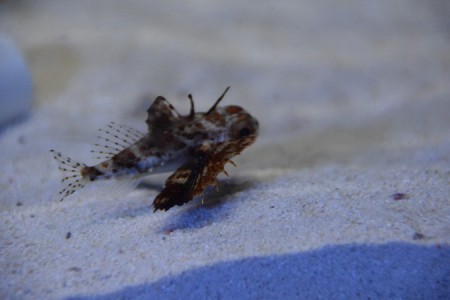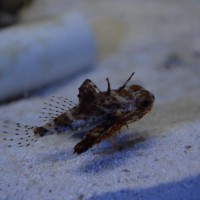- Name:
Flying gurnard
(View AKA's) - Family: Dactylopteridae
- Species: Batfish
- Scientific Name: Dactyloptena orientalis



More Details
General info about Flying gurnard
The flying gurnard, Dactyloptena orientalis, is a fascinating species that is characterized by its large, wing-like pectoral fins. It can reach up to 18 inches in length, making it a medium-sized fish. Flying gurnards are known for their bright and colorful appearance, which includes shades of blue, green, red, and yellow.
Flying gurnard Diet & Nutrition
Flying gurnards are carnivorous and feed on a variety of small fishes, crustaceans, and other invertebrates. In captivity, they can be fed a diet of small live or frozen foods, such as brine shrimp, krill, and small pieces of fish.
Determining Sex of Flying gurnard
There are no visible differences between male and female flying gurnards.
Breeding & Spawning Flying gurnard
Little is known about the breeding habits of flying gurnards in the wild or in captivity.
Common Diseases with Flying gurnard
Flying gurnards are generally hardy and do not suffer from many diseases. However, they are susceptible to bacterial infections, especially if the water quality is poor. It is important to maintain good water quality and provide a healthy diet to prevent illnesses.
Flying gurnard Origin
Flying gurnards are found in the Indo-Pacific region, including the coasts of Japan, China, and Australia.
Caution with Flying gurnard
Flying gurnards have venomous spines on their pectoral fins, which they use for defense. It is important to handle them carefully and avoid touching these spines. Additionally, flying gurnards require a large aquarium with plenty of open space for swimming, as well as a sandy substrate for burrowing.
Acclimating Flying gurnard
Flying gurnards should be slowly acclimated to their new environment using a drip acclimation method over a period of 1-2 hours to prevent shock.
Flying gurnard are Venomous
Original Detail
| Name | Species | Family | Scientific Name | More Detail | Added by |
|---|---|---|---|---|---|
| Flying gurnard | Batfish | Dactylopteridae | Dactyloptena orientalis | The flying gurnard, Dactyloptena orientalis, is a fascinating species that is characterized by its large, wing-like pectoral fins. It can reach up to 18 inches in length, making it a medium-sized fish. Flying gurnards are known for their bright and colorful appearance, which includes shades of blue, green, red, and yellow. | PalaciosAn |
Changed by users
| Submitted Date | Submitted By | Status | Action |
|---|


